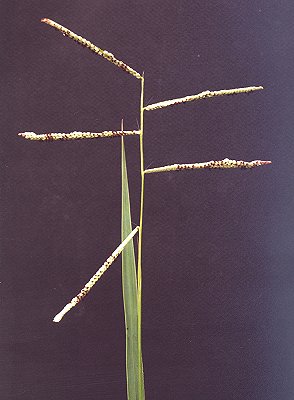 |
 |
|
 |
 |
|

Paspalum longifolium Roxb.
|
Derivation
Paspalum L., Syst. Nat. 10th edn, 855 (1759); from the Greek paspalos
(a kind of millet).
longifolium- from the Latin longus (long) and folium (leaf). With long leaf-blades.
Published in
Fl. Ind. Carey 1: 283 (1820).
Habit
Perennial, tufted. Cataphylls present. Stolons absent. Culms erect, 30–130
cm tall, 5–12-noded. Mid-culm nodes glabrous. Lateral branches sparsely
branched. Leaf-sheaths glabrous on surface or hirsute. Leaf-sheaths outer margin
glabrous or hairy. Leaf-sheath auricles absent. Ligule an eciliate membrane,
1–3 mm long. Leaf-blades 9–35 cm long, 3–9 mm wide. Leaf-blade
surface smooth, glabrous or hirsute. Leaf-blade margins scabrous.
Inflorescence
Inflorescence compound, a panicle of racemes. Racemes (1–)2–5(–12),
spreading, unilateral, 1.5–12 cm long, 2–3.2 mm wide, bearing 90–150
fertile spikelets on each. Central inflorescence axis 1–15 cm long. Rhachis
broadly winged, with sharp-edged midrib, 1.7–3 mm wide, scabrous on margins.
Spikelet packing regular, 4-rowed.
Spikelets
Spikelets in pairs. Pedicels oblong, 0.3–1.2 mm long. Fertile spikelets
2-flowered, comprising 1 fertile floret, lower floret sterile, upper fertile,
without rhachilla extension, obovate, dorsally compressed, plano-convex, obtuse,
1.7–3 mm long, falling entire.
Glumes
Glume 1 (the lower absent or obscure), thinner than fertile lemma. Upper glume
obovate, 2.1–3 mm long, 100% of length of spikelet, hyaline or membranous
or chartaceous, 3–5-nerved. Upper glume surface glabrous or puberulous
or villous. Upper glume margins eciliate. Upper glume apex obtuse.
Florets
Basal sterile floret 1, without significant palea. Lemma of lower sterile floret
similar to upper glume, ovate, 2.1–3 mm long, 100% of length of spikelet,
chartaceous, 3–5-nerved, glabrous or puberulous, obtuse. Fertile lemma
elliptic or obovate, gibbous, 1.6–3 mm long, indurate, yellow, glossy.
Lemma margins involute. Lemma apex obtuse. Palea involute, indurate. Anthers
3, 0.8–1.2 mm long.
Continental Distribution:
Temperate Asia, Tropical Asia, Australasia, Pacific.
Australian Distribution:
Northern Territory, Queensland, New South Wales.
Northern Territory: Darwin & Gulf, Victoria River. Queensland: Cook, Burke, North Kennedy, South Kennedy, Port Curtis, Wide Bay, Moreton. New South Wales: North Coast.
Classification. (GPWG
2001):
Panicoideae: Paniceae
Notes
Native. In tropical heaths, tropical and subtropical rain forests, and tropical
and subtropical sub-humid woodlands. Usually associated with damp soils and
grazed in moderation. Flowers mostly Nov.–May.

Inflorescence (photo)
© B. Hacker